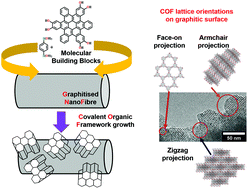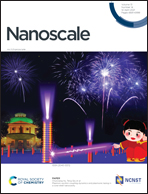Imaging and analysis of covalent organic framework crystallites on a carbon surface: a nanocrystalline scaly COF/nanotube hybrid†
Abstract
Synthesis of covalent organic frameworks (COFs) is well-advanced but understanding their nanoscale structure and interaction with other materials remains a significant challenge. Here, we have developed a methodology for the detailed imaging and analysis of COF crystallites using carbon nanotube substrates for COF characterisation. Detailed investigation using powder X-ray diffraction, infrared spectroscopy, mass spectrometry and scanning electron microscopy in conjunction with a local probe method, transmission electron microscopy (TEM), revealed details of COF growth and nucleation at the nanoscale. A boronate ester COF undergoes preferential growth in the a–b crystallographic plane under solvothermal conditions. Carbon nanotubes were found to not impact the mode of COF growth, but the crystallites on nanotubes were smaller than COF crystallites not on supports. COF crystalline regions with sizes of tens of nanometres exhibited preferred orientation on nanotube surfaces, where the c-axis is oriented between 50 and 90° relative to the carbon surface. The COF/nanotube hybrid structure was found to be more complex than the previously suggested concentric core–shell model and can be better described as a nanocrystalline scaly COF/nanotube hybrid.



 Please wait while we load your content...
Please wait while we load your content...